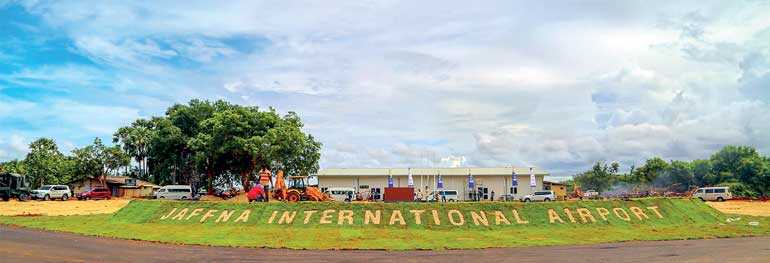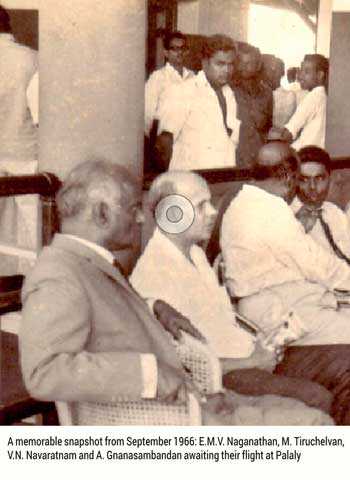Monday Apr 21, 2025
Monday Apr 21, 2025
Thursday, 17 October 2019 00:56 - - {{hitsCtrl.values.hits}}

The Jaffna International Airport
By N. Lohathayalan
The Palaly Airport was opened on 359 acres of land by the British Armed Forces, with the first flight to India being made on 10 December 1947. As of today, it will function as the Jaffna International Airport.
The ceremonial opening of the airport today brings joy not only to the people of Jaffna but for to those for whom Sri Lanka is home. The benefits to all Sri Lankans are immense (see S.R.H. Hoole ‘Our permanent umbilical connectivity to India’ Daily FT, 16 August 2019).
The request to upgrade the old Palaly Aerodrome was first forwarded by TNA MP Mavai Senathirajah in 2014 to the then-Indian Consul in Jaffna. Promising to take serious note of the request, the Consul carried it to the Indian Government, where upon reaching the Indian Prime Minister, it received the status of an agreement between the governments of Sri Lanka and India in 2015. Yet, to implement the agreement even after Budget estimates were made, all administrative arrangements were handled in secrecy.
With two governments involved, the veil of secrecy could not last long. By the end of 2015, when the plans became well-known, the Maithripala Sirisena-Ranil Wickremesinghe Government officially gave it the green light. When the matter reached the hands of administrators in Colombo, however, they applied the brakes. 
Early objections
Perhaps these administrators mistakenly thought that as a result of the airport, the economy of the North may flower at the expense of the Southern economy. Economists, however, think this is lopsided communal thinking and that the whole of Sri Lanka will benefit as trade with India surely will increase with tourism and cultural tie-ups.
At the same time, the then-Chief Minister of the North, C.V. Wigneswaran, did not like the scheme. He firmly communicated his anti-development view to Indian officialdom. The Chief Minister was estranged from the TNA by then. It was a case of not wanting the TNA to get too much credit for the development that would come. As a result, India seemed reluctant to carry forward the development of the airport when the Northern Provincial Council (in the form of its head) was so opposed to it. India set out to ask if the TNA shared the Chief Minister’s views and concluded that it did not.
This was the time when the TNA was exerting severe pressure not only on India but also on Prime Minister Ranil Wickremesinghe over the airport. Mavai Senathirajah and M.A. Sumanthiran were the foremost pressure bearers. For these reasons, India consented to the development of Palaly as part of its aid plan to Sri Lanka. India then proceeded with its plans. The Indian Consuls in Jaffna took a keen interest in the airport’s development, sometimes personally inspecting it.
Following this, to start flights from India, on 14 March 2016 Chennai Airport Director Deepak Shastri, arrived with a team at Palaly and began technical and feasibility studies. As this was ongoing, Chef Minister Wigneswaran dropped a scaremongering bombshell – he suggested that in the name of developing the airport, all the lands in the locality belonging to Tamils would be taken over by the Armed Forces. Regardless, the Shastri-led team issued a report stating that India’s work could be done within the little area around the airport.
Determined to contribute to Palaly’s development, the Indian Government produced not only development plan drawings but also a three-dimensional figure of the airport. These plans alone cost INR 15,000,000. When permission was sought from the Sri Lankan Civil Aviation Authority, further pressures appeared. The objection was now raised that if the Palaly Airport was developed and direct flights commenced from Jaffna, income from the Katunayake Airport would drop. The permission sought was denied. It was claimed that these Indian efforts would lead to a decline in Sri Lanka’s income. The project seemed to have run aground.
As 2017 drew to a close, and 2018 advanced, prospects for the airport project seemed dim. As a result, the onus of satisfying officials at the Civil Aviation Authority fell to the Prime Minister and his Government.
PM’s political manoeuvring
If the minority Government wanted to continue in office, it badly needed the TNA’s parliamentary support. However, the TNA was firm that the airport should be developed to international status. As a result, the Prime Minister gave a commitment that at the same time that Palaly becomes an international airport, the Ratmalana Airport too would be upgraded to an international airport. With this offer, the Prime Minister requested the Civil Aviation Authority to allow Palaly to be developed. It seemed that by raising communal objections in Sri Lanka, the elected Prime Minister could be checkmated by a determined civil service.
Although the Civil Aviation Authority officials agreed, they made the additional demand that the development must not be conducted using loans from India, for they saw the loss of Sri Lankan control if that happened. So they said that development must be at India’s cost and its first stage must involve making the airport a regional airport.
The Prime Minister wanted the TNA badly. He is also a pro-development man. So he agreed and gave the green light to seek Indian aid for the next stage, making the airport an international one.
Perhaps these administrators mistakenly thought that as a result of the airport, the economy of the North may flower at the expense of the Southern economy. Economists, however, think this is lopsided communal thinking and that the whole of Sri Lanka will benefit as trade with India surely will increase with tourism and cultural tie-ups
It was during this period that civil society groups came in droves to the Indian consulate in Jaffna. They noted that the Indians were focusing development on Jaffna whereas the East too had suffered during the war. It is like an ophthalmologist treating only one eye of a patient, observed a Batticaloa man. As a result, Indians began speaking of developing the Batticaloa Airport as well.
It is as a result of all this, that the Ratmalana, Jaffna and Batticaloa airports were all upgraded to the status of international airports. As a result, Jaffna gets to be Sri Lanka’s fifth international airport, the remaining two being Katunayake and Mattala.
In truth, it was during the Second World War that British forces established Palaly Airport to land small aircraft. Following that, on 10 December 1947, the first air services to India began.
The 1950s and 1960s saw extensive cultural exchange between India and Ceylon. Many went to India for their university education and returned as teachers in Jaffna schools. One English teacher, still living in the Jaffna town area, says that he would cycle close to the airport, get a friend living there to pillion him the rest of the way to the airport and take the bicycle to his own home. This teacher would take the flight from Palaly and return a week or two later, pick up his bicycle and go home. This is how he finished his studies – at the lowest possible cost, he insists.
Travel to Colombo by Jaffna’s elite was also done by the DC-10 flights from Palaly as seen in the photograph where Federal Party stalwarts are awaiting their fight to Colombo. Top government servants eligible for three sets of first-class railway warrants would get three of the six eligible journeys written out for KKS to Galle and back (the longest journeys by train and therefore the costliest) and then exchange these with Air Ceylon for tickets from Palaly to Colombo.
Civil war years
During the civil war, the airport was taken over by the Sri Lankan Army. As a result, in 1985 without the consent of locals, a further 646 acres of land were acquired by the Army. The airport and Army camps were expanded in this period.
It was also during this period that the 1987 Indo-Lanka accord was signed and on the day following the signing of the accord, Indian forces arrived on Indian aircraft without any entry visa. After this, when war broke out between the LTTE and Indian forces, thousands of mainly socially downtrodden youths who had worked with India on almost compulsory conscription, such as from the EPRLF and ENDLF, escaped to Colombo in 1989 using the same airport.
At the time, the regular two-way journey cost Rs. 3,000. But these youths were charged Rs. 5,000 by the Sri Lankan Air Force for their journey. At the time (around 1990) a sovereign of gold was priced at Rs. 4,500.
Amidst this state of affairs, on 10 June 1990, the Second Eelam War began. On 15 June 1990, the entire population of the area evacuated Jaffna under compulsion.
After this, the Air Force ran a regular service to Colombo and in 2013 internal flights were increased in number.
It is against this backdrop that Jaffna today opens its own international airport at a cost of Rs. 2.26 billion. The President had agreed to open the airport with the Prime Minister. As he has essentially given up political office, his opening of the airport together with the Prime Minister removed objections to the function during election time. But after invitations were printed, he has been evasive. With everything going wrong for him, he is like a spoilt brat, said an annoyed event organiser at the Kachcheri.
Another spoilsport, the Air Force Commander no less, has denied permission every time someone asked for something. Most egregiously on 16 September, after a heavy morning’s work, Indian officials asked for tea. “You are doing this for Tamils but want me to serve you tea?” the Commander responded. The Indians had to send a jeep to KKS to get refreshments.
Others have hinted, “Go ahead for now. After 16 November we will shut down this airport.” This is why all those who want the airport are pressing ahead to open it before elections. Through our ballot, good Sri Lankans must ensure that the airport will not be shut down.
In the meantime, in case the President does not come, the Prime Minister has been cleared by the Election Commission to open the airport provided there are no political speeches and other politicians are also invited.
However it goes, today is a joyous day for all Sri Lankans. This is thanks to the Prime Minister’s partnership with the TNA, Indian generosity and persistence in helping Tamils as well as the Government’s efforts to ensure a peaceful and inclusive Sri Lanka where development is for everyone.
Discover Kapruka, the leading online shopping platform in Sri Lanka, where you can conveniently send Gifts and Flowers to your loved ones for any event including Valentine ’s Day. Explore a wide range of popular Shopping Categories on Kapruka, including Toys, Groceries, Electronics, Birthday Cakes, Fruits, Chocolates, Flower Bouquets, Clothing, Watches, Lingerie, Gift Sets and Jewellery. Also if you’re interested in selling with Kapruka, Partner Central by Kapruka is the best solution to start with. Moreover, through Kapruka Global Shop, you can also enjoy the convenience of purchasing products from renowned platforms like Amazon and eBay and have them delivered to Sri Lanka.
Discover Kapruka, the leading online shopping platform in Sri Lanka, where you can conveniently send Gifts and Flowers to your loved ones for any event including Valentine ’s Day. Explore a wide range of popular Shopping Categories on Kapruka, including Toys, Groceries, Electronics, Birthday Cakes, Fruits, Chocolates, Flower Bouquets, Clothing, Watches, Lingerie, Gift Sets and Jewellery. Also if you’re interested in selling with Kapruka, Partner Central by Kapruka is the best solution to start with. Moreover, through Kapruka Global Shop, you can also enjoy the convenience of purchasing products from renowned platforms like Amazon and eBay and have them delivered to Sri Lanka.